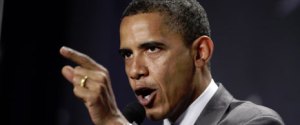
White House officials have unveiled details of President Obama’s National Wireless Initiative, first outlined last month during the president’s State of the Union address. According to the plan, 4G wireless broadband options would be available to 98 percent of the United States within five years via a series of public-private partnerships that will see the wireless industry building out infrastructure with legislative and other support from the federal government. The system would also include and interoperable nationwide public safety network for emergency responders and other public service personnel—and reduce the nation’s deficit by some $9.6 billion through monies collected through new spectrum auctions.
President Obama is expected to outline details of the plan today at an event in Marquette, Michigan, which will feature a distance-learning session powered by a 4G WiMax network at Northern Michigan University.
Part of the plan would authorize the Federal Communications Commission to reallocate and auction off some 500 MHz of spectrum space for the wireless industry during the next ten years, moving government agencies and private enterprises like remaining television broadcasters out of the spectrum space. Ideally, the FCC would conduct these as incentive auctions, whereby existing license holders in the spectrum space would give up their licenses in exchange for a cut of the sale price. Almost $11 billion of the money anticipated to be raised from the spectrum auctions would go to fund a public safety network—an interoperable, high-speed public safely network was one of the key proposals of the 9/11 Commission back in 2004.
The plan also calls for the federal government to make a one-time contribution of $5 billion to the FCC’s Universal Service Fund to subsidize build-out of wireless infrastructure to remote and rural areas where wireless providers otherwise wouldn’t see a business reason to put in service: companies receiving money from the Universal Service Fund to build in those areas would have to agree to build facilities that interoperate with public safety systems for emergency responders. An additional $3 billion raised from spectrum auctions would go towards a Wireless Innovation fund (WIN) to develop and test new mobile technology for use in the energy and health care industries, as well as education.
Policy makers have generally posited that development of a nationwide wireless broadband network that reaches the vast majority of Americans is critical to keeping the United States competitive in a wide variety of fields, not just computing, mobile technology, and the all important professional Facebook friending. By improving access to distance learning, remote work opportunities, and reliable communications, wireless broadband infrastructure can help reduce costs and improve responsiveness for a broad number of industries. However, the FCC’s current stance on mobile neutrality—enabling mobile operators to essentially block or favor any applications and services they like—may severely limit the utility of privately operated mobile networks—particularly in remote and rural areas served only by a single operator.


